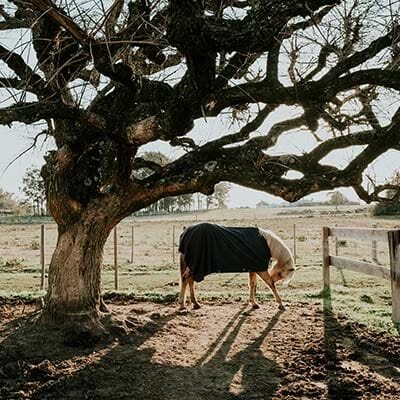The Reason for Blanketing Horses
February 4, 2022
Written by Amber Gayheart, Programming Coordinator

When you look at a field filled with horses in the middle of winter, you might notice that some horses are wearing blankets. You may also notice that other horses are not wearing these blankets. At Liberty Mountain Equestrian Center, we have a wide variety of horses with different blanketing needs. Let’s find out the difference and why a horse would need to wear a blanket vs why they wouldn’t.
A Horse’s Natural Coat
Horses are designed to be able to regulate their body temperature in cold and hot weather. In the winter, a horse has the ability to make itself warmer by growing out a fluffy coat. The longer the horse’s hair is, the easier it is for the horse to hold heat between its fur and its skin. Another unique quality that horses have that helps them to stay warm is they huddle together in order to share body heat. Horses are herd animals and, with that, they can share not only body heat but also protection from the elements (rain, wind, predators, etc.).
There are more than a few reasons why we would need to blanket a horse when it is cold outside. Let’s talk about a couple of those reasons:
Performance Horses
For performance horses, like many of the horses we have at the Equestrian Center, an extremely long coat of fur makes the horse more susceptible to sweating when they are in a lesson or practice. To remedy this, we often body clip our horses or shave their hair coat to make them cooler when they are being ridden. When horses lose their hair coat it is harder for them to keep warm on their own. This is where a blanket can help regulate their body heat! The blanket will trap the heat between the horse’s hair and their skin, acting as a barrier for their natural body heat.
Rain or Snow
Another reason that a horse may need to be blanketed is rain or snow. When a horse’s fur gets wet it makes it very hard for the horse to keep its body heat up. When we put a blanket on a horse, it helps keep the rain from permeating the fur and compromising the natural heat barrier. PS – always make sure the blanket is waterproof!
Strong Wind
One other natural factor that would compromise the horse’s ability to keep warm is a strong wind. Mixing wind with cold temperatures can make it really hard for a horse to stay warm. If you have ever worn a sweater on a cold, blustery day you may know this feeling well. It is hard to combat cold temperatures and wind at the same time
Different Types of Blankets
In the same way that we, as humans, have different jackets that we wear in different weather, horses have the same type of wardrobe. Let’s go over some of the different blankets!
The first is a waterproof sheet. A sheet usually has no filling and is a good option for a horse with a medium-length coat — especially if there is rain in the forecast. The next is a medium-weight blanket. This just means that there is filling, much like the filling you would find in a jacket for people, on the inside of the blanket making it a bit warmer than a sheet. The last blanket is a heavyweight. This is good for shaved horses because it has more filling and helps the horse stay toasty warm.
While there are many different reasons why horse owners would blanket their horses in the winter, these are just a couple of reasons why you might see a horse with a blanket on at the Equestrian Center. If you have any questions about horse blanketing during the winter months, come visit us at the Liberty Mountain Equestrian Center!
